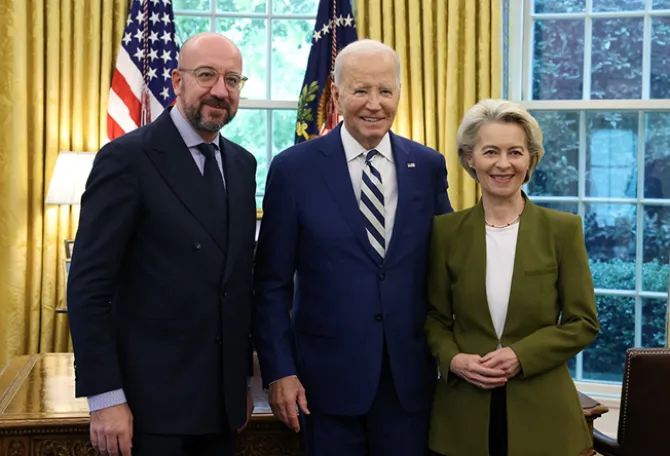
On 20 October, European Commission President Ursula von der Leyen and Chief of the European Council Charles Michel met United States (US) President Joe Biden for the European Union-US summit in Washington. The previous EU-US summit took place in June 2021, where the focus was on strengthening the transatlantic partnership that had witnessed turbulent times during the Trump administration. Since then, the Ukraine conflict has reinforced the transatlantic alliance, which has coordinated effectively to counter Russian aggression through sanctions, weapons supplies, and other measures. The summit this year, which transpired in a fundamentally altered world confronted by two deadly conflicts, was an opportunity to showcase unity and strength.
United in geopolitics
Indeed, the two sides succeeded in presenting a united front on the big geopolitical issues of the day.
The Ukraine conflict has reinforced the transatlantic alliance, which has coordinated effectively to counter Russian aggression through sanctions, weapons supplies, and other measures.
A comprehensive eight-page joint statement reiterated “unwavering long-term political, financial, humanitarian, and military support to Ukraine” and vowed to “deepen EU-US cooperation and engagement on security and defence”, with NATO at its core. It also affirmed Israel’s right to defend itself amidst the escalating violence in West Asia. On China, the statement emphasised “constructive and stable relations”, while expressing concerns about the East and South China Seas, the Taiwan Strait, and human rights in Tibet and Xinjiang. It agreed on de-risking critical dependencies and diversifying supply chains. Yet while the statement reflected widespread alignment on geopolitical matters, the statements on economic cooperation were less emphatic. This is unsurprising since an inability to reconcile on trade policies has become a major irritant in the transatlantic relationship.
Economic bones of contention
Together the steel and aluminium industries are responsible for a tenth of carbon emissions worldwide. In recent years, EU-US trade relations have been characterised by a longstanding dispute since the Trump administration slapped tariffs on EU steel and aluminium imports in 2018. Even though the Biden administration suspended the tariffs for two years, a 31 October deadline was set to avoid their reimposition. However, a deal proved elusive at the summit due to Brussels’ reluctance, amid concerns about complying with World Trade Organisation (WTO) rules, to levy tariffs on non-market economies like China to address overcapacity and promote cleaner steel.
EU-US trade relations have been characterised by a longstanding dispute since the Trump administration slapped tariffs on EU steel and aluminium imports in 2018.
In the absence of any substantial progress on this issue, the joint statement merely affirmed the progress made “to identify sources of non-market excess capacity” and “better understanding of the tools to address the emissions intensity of the steel and aluminium industries”. The summit was a lost opportunity since with American elections looming in 2024, it is unlikely that Biden would risk alienating key steelmaking swing states such as Ohio and Pennsylvania. Besides, the EU and US, despite converging on some of the threats China poses, do not always see eye to eye on how to tackle the China challenge, with Europe still hesitant in overtly targeting China based on high levels of economic dependencies. Another issue awaiting resolution involves critical minerals that would grant the EU exemptions in Biden’s US$370 billion Inflation Reduction Act (IRA). The IRA aims to provide subsidies to American companies to accelerate the green energy transition, but European firms fear that the subsidies, while advantaging US businesses, will impact European carmakers selling electric vehicles. An agreement on critical minerals extracted or processed in the EU is meant to provide European automobile companies access to the Clean Vehicle Credit under the IRA and level the playing field.
Reconciling trade policy
It is no secret that the transatlantic relationship has struggled to live up to its potential in the area of economics and trade.
The IRA aims to provide subsidies to American companies to accelerate the green energy transition, but European firms fear that the subsidies, while advantaging US businesses, will impact European carmakers selling electric vehicles.
Despite vying to expand economic relations with ‘likeminded’ nations to strengthen economic security, negotiations for the Transatlantic Trade and Investment Partnership (TTIP)—a proposed trade deal between the EU and the US that collapsed after years of negotiations from 2013-2016—are unlikely to be revived given the prevalence of trade barriers on both sides. This was evident in the pushback that German Chancellor Olaf Scholz’s proposal to restart talks received from Brussels and Washington. With an upcoming EU-US Trade and Technology Council meeting—a mechanism to address bilateral trade and tech issues—scheduled for December, it remains to be seen whether the two sides can achieve meaningful breakthroughs on these disagreements. However, with elections due in 2024 in both the EU and the US, stabilising the relationship and easing lingering tensions before potential changes in leadership are important. Together, the EU and US represent almost 800 million citizens and an economic relationship worth US$7.1 trillion. Against an increasingly volatile global backdrop that has clearly demonstrated the impossibility of delinking economics from geopolitics, it would be useful for the EU and US to address these persistent bones of contention and deepen their economic engagement.
Shairee Malhotra is an Associate Fellow with the Strategic Studies Programme at the Observer Research Foundation.
The views expressed above belong to the author(s). ORF research and analyses now available on Telegram! Click here to access our curated content — blogs, longforms and interviews.




 PREV
PREV

